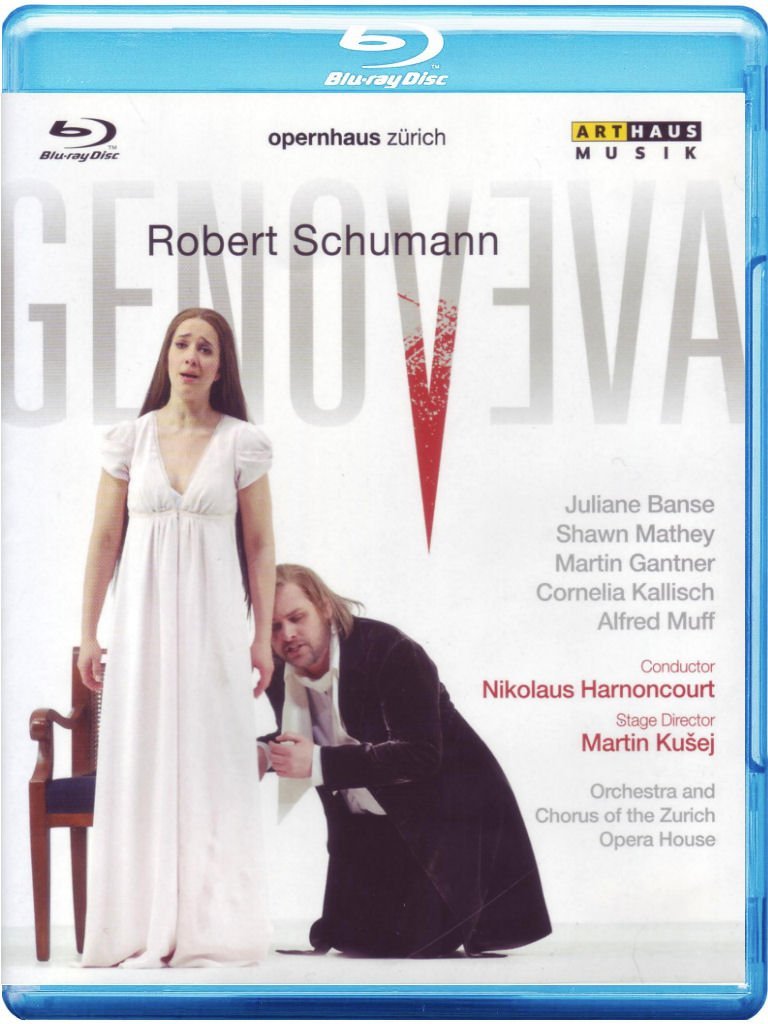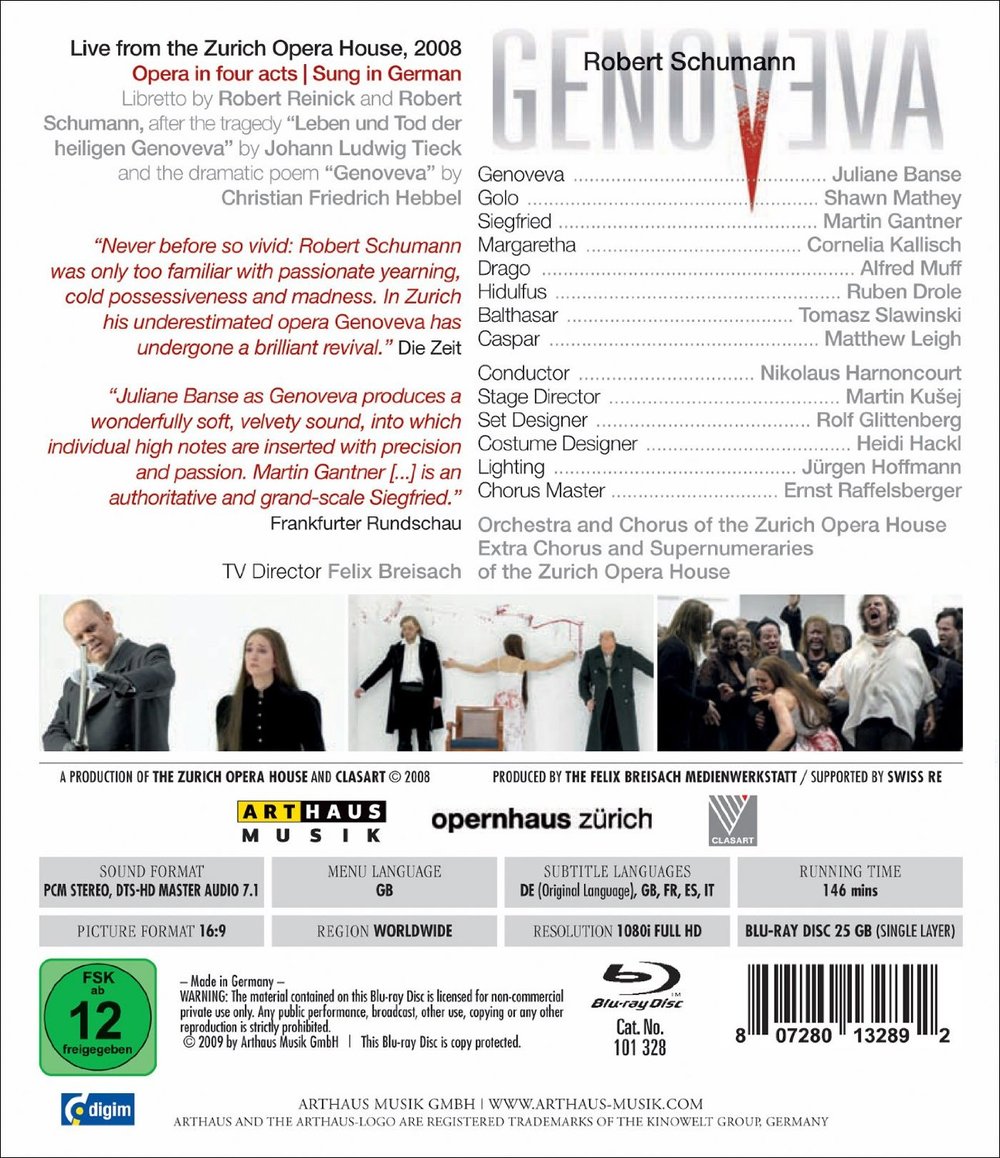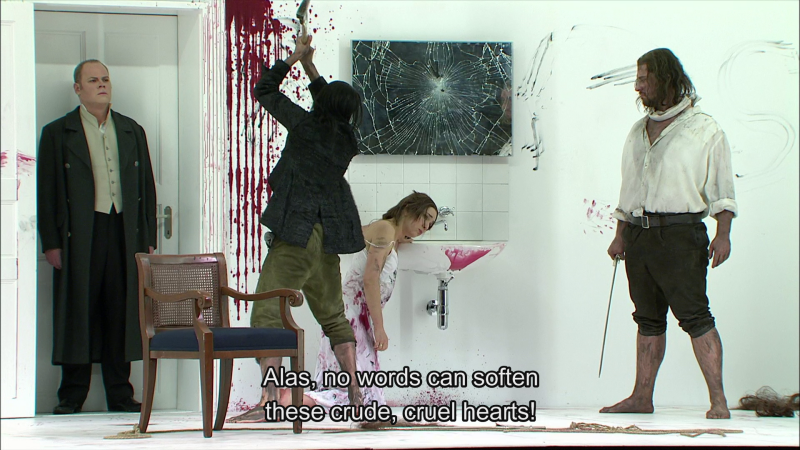

Robert Schumann Genoveva opera with libretto by Robert Reinick and the composer. Directed 2008 by Martin Kušej at the Zurich Opera House. Stars Juliane Banse (Genoveva), Shawn Mathey (Golo), Martin Gantner (Siegfried), Cornelia Kallisch (Margaretha), Alfred Muff (Drago), Ruben Drole (Hidulfus), Tomasz Slawinski (Balthasar), and Matthew Leigh (Caspar). Nikolaus Harnoncourt directs the Orchestra and Chorus of the Zurich Opera House (Chorus master Ernst Raffelsberger). Set by Rolf Glittenburg; costumes by Heidi Hackl; lighting by Jürgen Hoffmann. Directed for TV by Felix Breisach. Sung in Germar. Released 2009, disc has 7.1 dts-HD Master Audio. Grade: B+
This is Schumann's only opera, an obscure work that has been seldom produced and few people have seen. The orchestra music is interesting. Annette Dasch sings some of the soprano music in her new HDVD recital recording. But the libretto is both thin on logic and bloated with old-fashion German Romanticism. So why not take a chance and see if you can spike the bowl with design and directing? Now pipe on board enfant terrible Martin Kušej, whom we know from HDVDs of Electra, Lady Macbeth of Mtsensk, Der Fliegende Holländer, and Rusalka.
Kušej likes to build a box within the stage; and within the box he creates his own abstract universe of symbolic and surreal images and actions—with emphasis on dislocation, inexplicable moves, garish violence, nudity, smearing, splatter, and the like (you know you're in trouble if the box says you have to be 12 years old to see the show). To the expert and the initiated, this can be bracing and profound; to the conservative viewer, it's challenging and sometimes even called Eurotrash.
Too bad we can't fetch Robert Schumann in a time machine and watch the expression of his face. My early inclination was to dial out the Kušej Genoveva—except for one thing. The videography on this disc is preternaturally superb. Kušej and Felix Breisach obviously worked hard together to come up with a film that might make a much bigger impact on opera fans than the 2008 live show possibly could have.
The Arthaus keepcase booklet has an excellent plot summary, so I will not dwell much on the story line. I'll focus on Kušej's psychological approach to opera directing and the video images Kušej and Breisach came up with.
Below is the Kušej box within a box. It fills maybe 30% of the vertical and horizontal dimensions of the opera stage, and it is set fairly far back. You should be able to see the stage floor in front of the box as well as part of the proscenium walls on both sides. And there are two boxes in the box in the box. I refer to the door frame, which has two doors hung on it (you will see that later) and the black horizontal box, which is a magic mirror:
Now for a near view of the Kušej box. Below is the opening scene. On the left praying is Duchess Genoveva (Juliane Banse). Her husband, Duke Siegfried (Martin Gantner), stands in the center. On the right stands the Knight Golo (Shawn Mathey), an illegitimate member of the aristocracy who is considered a Lord of the estate and is admired and trusted by Siegfried. Lying on the floor is Margaretha, an old wet-nurse turned witch who raised Golo but was banished from the realm long ago. I should mention that none of these people is actually there. At this point, Kušej is just showing you his main cast. Whether a character is actually there depends entirely on whether the character is doing something called for by the plot. At this point nothing has happened yet, so nobody is actually there. The four main characters are inside the box, which is stark white, most of the time. Supporting characters live in the gloom outside of the box, and we see them only when they enter the box for their lines. It's appropriate to keep the four main characters visible in the box because each of them stands for a different aspect of human nature. To keep all this straight, you have to pay attention. But Kušej give you lots of clues—if a character is not really there, he may lie on the floor or stand with his back to the action (hang in there):
A portrait of the Duchess. When I see this in my HT, I think of fine portrait photography (like when you pay $5,000 for a studio session and then get to pick one of 5 or so proofs to put on your desk):
A portrait of the Duke:
Trusted friend Golo is religious and conscientious—and also utterly vile:
A better shot of Margaretha. The blackface has nothing to do with race. Commoners who do not at least do noble things get blackface (pure Kušej):
Below on the left is Drago (Alfred Muff), an honest friend of the Duke who is left in charge of the household while the Duke goes to war. In this shot both Drago and the Duke are actually there because they are singing to each other:
Below Golo is singing an honest and introspective soliloquy about his troubled life. He's singing to you. You have already figured out that the Duke and Duchess are not actually there. He's standing on the chair because Kušej thinks this reveals something about Golo. (Golo is actually standing on the floor.) Kušej often has his character do strange things that reveal aspects of their souls. For example, when Genoveva has significant physical or psychological contact with her husband, she often looses her balance and almost falls down:
Siegfried stands for masculine logic and discipline. He's going off to war and he kisses his wife several times by slightly tapping her forehead with his lips:
Although Golo is supposed to be the Duke's close friend and confidant, he's secretly in love with Genoveva. When Genoveva swoons at the Duke's departure, Golo can't resist temptation:
Golo states, "Ich will, Ich muß sie küssen." which in English might be "I want to, I must kiss her (or her lips)." (It sure looks like Schumann is quoting Mozart. "Ich muss sie küssen" are also the words used by Monostatus when he tries to kiss the unconscious Pamina in Die Zauberflöte.)
Margaretha sees her chance to get revenge on both the Duke and Golo:
After some debate, Golo decides to try to take Genoveva away from the Duke. In the scene below, you will understand that Golo is actually singing alone:
The household is not running smoothly with the Duke at war:
Golo makes his play for Genoveva who fights back with the only weapon she has—words:
The door is hung with two doors. There's a space between the doors as wide as the thickness of the wall, which creates the alcove called by in the libretto. Genoveva and Drago are the only faithful members of the Duke's circle left at home. Golo has cooked up a scheme to frame both of them:
The guards find both Drago and the Genoveva in her chambers. Drago is slain and Genoveva arrested:
Siegfried learns that there's trouble at home. In a vision, Genoveva is pelted by the chorus with dead fish and slain with Siegfried's sword. Use this image as your PC wallpaper at work and see what questions you get:
Drago comes back from the dead to confront Margaretha. He stands on the washbasin, which is now running over with blood. This scene is Schumann's variation on the Commendatore's visit for dinner at the end of Don Giovanni:
Now we see the the tormenting of Genoveva under arrest. With a rope around her neck, Juliane Banse repeatedly climbs over the bloody wash basin. This must have been very difficult to do and presented Banse with a real risk of a nasty fall injury:
Siegfried ordered Golo to execute Genoveva:
Genoveva seeks martyrdom and welcomes her humiliations:
I'm not going to tell you how this ends. This last image is at the end of the curtain calls, and Banshe still hasn't recovered from the stress of her role:
Can you imagine how boring all this would be if performed as an historical costume drama? Logical weaknesses in the plot would kill it. But here it's performed, quoting the keepcase booklet, as a "modern-day drama of the soul." And the keepcase booklet has 6 pages of high-level theory about ways to interpret Kušej's vision. The more you watch this, the more interesting it gets. Perhaps the screenshots here will inspire you to buy the disc and get started. I originally gave this a C+ grade in 2011. But now that I understand modern opera better, I've moved the grade up to B+.




























